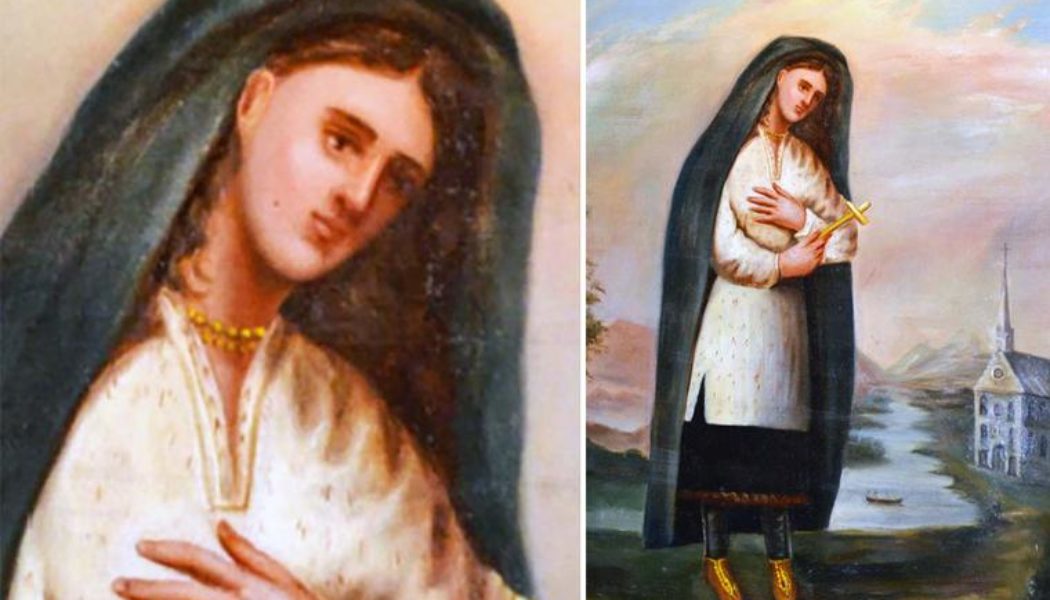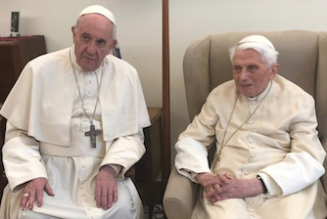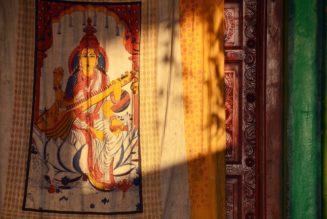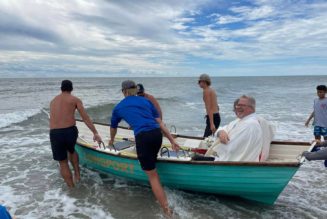
St. Kateri Tekakwitha is one of the most amazing saints of North America, but few people have yet to meet the real St. Kateri Tekakwitha or the path of holiness she traveled.
St. Kateri is the first canonized indigenous woman of North America, and the second indigenous person of North America to be canonized (that honor goes to St. Juan Diego Cuauhtlatoatzin, whose tilma was used by the Virgin Mary to imprint her image).
St. Kateri was born in 1656 at Ossernenon (near present-day Auriesville, N.Y.), a major town of the Mohawk nation or the Kanienʼkehá꞉ka (“People of the Flint“), one of then-Five Nations of the Haudenosaunee (Iroquois) Confederacy. Today, they are called the Six Nations. St. Kateri died at 24 years old in Kahnawake, a praying village established by Haudenosaunee Catholics along the St. Lawrence river in 1680 and which is an important part of the Mohawk nation today.
Most Catholics have an incomplete picture or understanding of St. Kateri, her life and times. However, rediscovering the historical details of St. Kateri’s life and times, situated within a rich appreciation of her Haudenosaunee and Mohawk culture, language and identity can make St. Kateri’s holiness shine all the more radiantly.
Some of these facts you may know. Others may surprise you. Here are the first 10 things you should know about St. Kateri Tekakwitha.
1. Without the Jesuit Martyrs, We’d Have No St. Kateri Tekakwitha.
Many people have speculated about the connection between the Jesuit Martyrs of Canada, and St. Kateri Tekakwitha. There are direct connections in the historical sequence of events, without which, we’d have no canonized “Lily of the Mohawk.”
The Mohawk nation is comprised of three separate extended family networks called clans: the Turtle clan, the Wolf clan, and the Bear clan. When St. Isaac Jogues returned to the Mohawk nation of his own free will, as both missionary and representative of the French government, his presence had caused quite a bit of division. During his captivity, St. Isaac Jogues had been initially perceived by the Mohawk as a coward, and unworthy either to be adopted into their nation like the Jesuit lay brother Guillame Couture (who was captured along with Jogues, adopted, and appointed a sachem of the Five Nations). Nor was Jogues worthy for the other option: to avenge the death of a loved one in ritual execution.
Jogues’s return after his escape provoked a re-evaluation, but consensus in the Mohawk nation frayed badly about what to do with Jogues. The Turtle Clan chose to protect Jogues, who by this time was adopted into the Wolf Clan, and assigned him a bodyguard, especially to protect him in areas where the saint would be vulnerable to attack, such as outside the palisade (where the Jesuit lay brother Jean deLalande was eventually killed, shortly after Jogues). One matter of historical speculation is whether Kenneronkwa, St. Kateri’s father, was the member of the Turtle Clan chosen to protect the Jesuit priest.
However, Jogues ended up being killed, and his Turtle bodyguard assaulted, in a trap set by members of the Bear Clan in the longhouse itself, a place traditionally considered off-limits to the use of weapons. So far, no artist has actually captured the truth of this dramatic moment in which members of all three Mohawk clans are caught up — the Wolf clan martyr, the Turtle clan bodyguard, and the Bear clan assailant.
The death of Jogues and Lalande in 1646 created a diplomatic crisis that ushered in a catastrophic final war between the Five Nations Haudenosaunee (Iroquois) Confederacy and the Wendat Confederacy.
2. Wendat Catholics Did What the Jesuit Missions Could Not — They Evangelized the Five Nations
The Haudenosaunee Five Nations struck hard at the Wendat Confederacy, overrunning their towns and destroying the Jesuit missions, and triumphed decisively by 1649.
Up to that point, both the Wendat and Haudenosaunee confederacies had maintained a balance of power in the region surrounding Lake Ontario and the St. Lawrence river — and by some measures, the Wendat even had the edge over the Haudenosaunee. But the Haudenosaunee secured a major technological and supply advantage with their Dutch allies liberally supplying them with guns and power, and hit the Wendat Confederacy with the full strength of their alliance. The French had fatally failed to match the Dutch military commitment to their own Wendat allies, who now found themselves decisively outmatched. With their heartland towns overrun, the Wendat Confederacy fell apart as a political alliance, but the survivors of the disaster would reconstitute themselves as today’s Wyandot and Wendat nations, the former heading east toward Detroit and the latter heading west toward Quebec. But nearly 1,000 Wendat would be taken captive, a vast many of them Catholic, and the majority would be adopted into the Five Nations whose traditional territory is in upstate New York.
While the Jesuit martyrs and missions were casualties of this disaster, the evangelization was not in vain but actually achieved what the Jesuit martyrs and Wendat martyrs had prayed for, even though it was unimaginable: the intensely Catholic Wendat would be adopted into the Five Nations, becoming part of their families, and build core Catholic communities across the Five Nations. These Catholics passed down the Church’s teachings through the strength of indigenous oral culture, and evangelized the very people who had once been their enemies.
The planting of the Church into the Mohawk heartland meant St. Kateri grew up with the witness of Mohawk Catholic converts in her own village. Second, these events are key to the founding of the “praying village” called Kahnawake, that St. Kateri would join in 1677, a year after her own conversion. Kahnawake was founded by a holy Oneida married couple in conjunction with the Jesuits. The husband, Francis Xavier Tonsaton, was originally a Wendat Catholic who had been captured and adopted into the Oneida nation, and was instrumental in the conversion of his wife who became a Catholic on fire for her faith. St. Kateri Tekakwitha is buried in a church that bears his namesake patron saint: St. Francis Xavier mission.
3. St. Kateri’s First Knowledge of the Catholic Faith Likely Came from Her Mother
St. Kateri was born in the Mohawk nation capital of Ossernenon (located in the vicinity of modern Auriesville, New York) in 1656 — 10 years after St. Isaac Jogues and Jean de Lalande’s martyrdom. St. Kateri’s father is believed to Kenneronkwa, one of the chiefs of the Turtle Clan who were elected by the clan mothers and responsible for political decision-making in the Mohawk nation. St. Kateri’s mother is believed to have been a Catholic Algonquin woman named Kahontáke (Meadow) from the Weskarini Band up near the Ottawa river in present-day Canada. She may have been captured and then adopted into the Mohawk nation during the 1650s.
St. Kateri’s father seems to have been intent on keeping peace between the Mohawk nation and the French, and tolerant of the spread of the Catholic faith in the Mohawk nation. St. Kateri’s mother would likely have been her first introduction to Jesus and Mary, and the Christian faith, as her children were growing up in a fully Mohawk culture. Kenneronkwa did not consent to the baptism of his children, but a smallpox epidemic in 1660 (part of the consequences of contact with the Europeans) claimed his life, and the lives of Kahontáke and St. Kateri’s brother. St. Kateri survived, but her face would be scarred and her vision badly damaged.
4. Her Uncle and Aunt Adopted St. Kateri and Gave Her the Name ‘Tekakwitha,’ It Would Be Prophetic
One of the strengths of Haudenosaunee culture is having strong extended families, which would live together in the longhouse owned by the head mother. St. Kateri’s uncle and aunt became her adopted father and mother, and in Haudenosaunee culture, that meant they treated St. Kateri exactly as if she were their own birth child.
Haudenosaunee parents typically gave their children names later in life, typically after observing unique things about them. St. Kateri’s adopted parents gave St. Kateri her name “Tekakwitha.”
The name’s meaning has been rendered into English as “she walks groping for her way.” Another rendering is “she puts things in their place.” In any event, St. Kateri’s parents caught onto both a physical fact — she had to feel her way about in order to walk forward — and a lifelong personality trait. St. Kateri would sometimes have to feel her way about for social cues (sometimes making unintentional missteps along the way), or she would make resolutions (such as not to get married) but then struggle to clearly articulate why she made them.
5. A French-Led Invasion Nearly Killed St. Kateri Tekakwitha
After the death of St. Kateri’s family from smallpox, her uncle/adopted father is chosen by the clan mothers to take his brother’s place as a chief of the Turtle clan, exercising leadership at the council fire of the Mohawk nation — a heavy burden amid enormous grief and trauma at losing so many family members. St. Kateri’s adopted father opts for a far more aggressive approach with the French. He wins a tactical victory, however, that leads to a strategic defeat for the Mohawk nation as his strategy backfires.
The French launch an invasion in 1666 with overwhelming force into the Mohawk heartland. In order to save lives, the Mohawk nation decides to avoid direct combat, and abandon their villages. The French, denied a shock battle, respond in a horrifying fashion: they decide to burn down Ossernenon but also the grain reserves, intending to condemn Mohawk men, women and children to death by starvation. Thankfully, St. Kateri and the Mohawk people survive because they can take refuge with the other four Haudenosaunee nations, which help stave off death thanks to their culture’s practice of putting three years of food in the ground for storage to help their people survive famine or similar disasters. They would rebuild, with each clan establishing its own principal village.
6. Holy Mohawk Catholics Gave a Convincing Witness of the Faith to St. Kateri
Most people do not realize that St. Kateri’s conversion owed a great deal to the many lay Catholics who witnessed to the Catholic faith, gave their testimony of life in Jesus Christ, and invited their fellow Mohawk to follow Jesus. While various Jesuit priests were part of St. Kateri’s instruction and formation in the faith, the evangelization by Mohawk Catholics, renowned in their culture and living out their faith as Mohawk people, deeply impressed her.
One of them was a clan mother — in the Haudenosaunee political tradition, the clan mothers elect the chiefs — whose name was Marie Tsiaouentes, and who was an outspoken witness of the Catholic faith, a catechist and a staunch opponent of the anti-Catholic Dutch for destroying Mohawk lives and wealth through trading alcohol for furs.
Another was the Mohawk war-hero-turned-evangelist Joseph Togouiroui. Another would have been the lay apostle Martin Skandegonraksen, a young man renowned for his charity, whom she heard speak about Jesus in public speeches as well as his beautiful hymn singing. He chose voluntary celibacy, and died in 1675, a year before St. Kateri’s conversion, after receiving a vision of Mary.
These and other witnesses demonstrated to St. Kateri that she could embrace this Catholic faith as a Mohawk woman faithful to her culture and people. But as in our own culture today, the choice to follow Jesus Christ can meet with painful opposition from family and members of one’s own community, especially when national politics are involved.
7. St. Kateri’s Saint’s Name Has Special Meanings for Her Catholic Identity and Mission
St. Kateri took the name “Kateri” or Catherine when she was finally baptized on Easter Sunday in 1676, but which St. Catherine she had in mind is a matter of speculation. Some biographers have posited the contemplative mystic St. Catherine of Siena. But also possible is St. Catherine of Alexandria, who was crushed under a wheel for her faith. Possibly she knew of and identified with both the mystic and the martyr, and so wanted to add that meaning to her given name and identity.
When she arrived in Kahnawake after her conversion, she would discover she shared the same name as the village’s foundress, Kateri Gandeaktenha. This Kateri was a devout Oneida Catholic married woman, who was introduced to the Catholic faith and the Jesuits by her husband Francis Xavier Tonsaton. Kateri Gandeaktenha was the driving force with her husband behind the formation of Kahnawake as a praying village, where Haudenosaunee people could live out their Catholic faith fully expressed through their culture and language. She died in 1673, renowned for her great charity, and was venerated as a saint by the time St. Kateri arrived. She was considered a “pillar of faith” and it became clear to devout Haudenosaunee Catholics there that St. Kateri Tekakwitha would take up Kateri Gandeaktenha’s legacy in a powerful way.
8. A Dramatic Public Division in the Mohawk Nation Led to St. Kateri’s Migration
By this time, many Mohawk people had become Catholic, but some had advocated that Mohawk Catholics should re-establish themselves at Kahnawake, which was situated on their traditional northern frontiers. It would serve a dual purpose: allow Mohawk Catholics to live their faith in an intentional way, and also position them to dominate a trading route with the French (and for the French, it would guard the southern approach to Montreal). But the problem was the distance from the Mohawk heartland, and heavy migration north threatened the Mohawk nation’s ability to maintain their home base and project strength as the “Keepers of the Eastern Door” for the Five Nations. This was a thorny political problem dividing families.
St. Kateri’s adopted father as a Turtle clan chief appears to have advocated for an aggressive, hardline approach to force people back into consensus and remain in the Mohawk heartland. A majority of the clan mothers, whom he would have consulted in Haudenosaunee political tradition, appeared to back this view. When Marie Tsiaouentes decided to migrate to Kahnawake, the clan mothers took the rare (and humiliating step) to impeach her from office as clan mother before her departure.
The hardline approach and hostile atmosphere however ends up making migration more attractive not less to Mohawk Catholics in the heartland. But St. Kateri has a problem: she is not simply “nobody” — she’s the daughter of a Turtle clan chief. Her family is tightly bound up in these politics. And then, her adopted sister becomes a Catholic and migrates with her husband to Kahnawake.
9. Heated Politics Too Close to Home Creates a Family Tragedy for St. Kateri
Even prior to her conversion, St. Kateri was in trouble with her adopted parents because she refused to get married and have a family — highly-prized Mohawk values and ones considered essential to personal, familial and national survival. She was an exemplary traditional Mohawk young woman, but her conversion to the Catholic faith in 1676 did not make things better in the highly polarized political environment.
Now, as a Catholic, St. Kateri decided she would observe the rhythm of Christian life by doing no work on Sundays and feasts, and making more time to pray — but to her adopted parents and many of her relatives it looked like St. Kateri was now abandoning her responsibilities to work so the nation could survive. Unfortunately, they resort to tactics that become progressively extreme: name-calling, shunning, harsh labor, and accusing her of betraying the country and not being truly Mohawk. One aunt went so far as to tell a very damaging lie about St. Kateri, accusing her of incest with one of her uncles, figuring the lie would prevent St. Kateri from migrating and finding any welcome in Kahnawake.
Eventually, St. Kateri summons up the courage to leave Caunghnawaga in the Mohawk heartland, and take the advice of the Jesuit priest in the village to join her other family and relatives in Kahnawake after the renowned Oneida Catholic chief Louis Garonhiague (or “Hot Powder”) gives a speech inviting people to join the Catholics there. She sets out with Garonhiague, her brother-in-law, and a Wendat Catholic. The news apparently enrages St. Kateri’s adopted father, who now has lost both his daughters to migration.
St. Kateri’s adopted father does not get a sympathetic treatment by the original Jesuit biographers of St. Kateri, but that is possibly due to the popular conventions of 18th-century hagiography and limitations of their own knowledge. A modern reader can perhaps grasp the interior struggle of a father who felt he was losing his family a second time — a feeling compounded by his political failures to keep his nation together in the heartland. He allegedly loads his gun with a musket ball for each of St. Kateri’s escorts, but by the time he encounters St. Kateri’s brother-in-law while gathering supplies there is no angry confrontation. He is simply looking for St. Kateri and asks where she went.
Perhaps it was a sign of hurt and anger turning into grief and resignation over his adopted daughter’s incomprehensible choices. In any event, there is no real pursuit and likely the clan mothers just confirmed this decision to let St. Kateri go her own way. Because St. Kateri dies in Kahnawake by 1680, the adopted father and daughter never had an opportunity to reconcile in this life.
10. Kahnawake Provided St. Kateri So Many Catholics Competing for Holiness
St. Kateri’s arrival in Kahnawake from 1677 meant she had come to a place where she could now live out her Catholic faith as a Mohawk woman in a community that 100% reflected her Haudenosaunee culture, language and identity lived through the Catholic faith. The entrance of the village had two trees — reminiscent of the Haudenosaunee tree of peace — under which people who entered would symbolically bury any drunkenness or sexual sins from their past life. Kahnawake had elected chiefs for peace, war and catechism, and the Jesuit priests were adopted into the different clans. In fact, following Haudenosaunee marriage tradition, the Jesuits prohibited marriage between members of the same clan. The traditional features of culture, agriculture, and governance remained the same but united with Catholic doctrine and practice.
At Kahnawake, St. Kateri and the Haudenosaunee Catholics attended Mass in the morning and Vespers with Benediction of the Blessed Sacrament in the evening, all sung in their own language as the priests prayed in Latin. They would hear the sermons preached by Haudenosaunee catechists. St. Kateri received the Holy Eucharist frequently and went to Confession every eight days. They took their rosaries with them as they worked in the fields. St. Kateri’s devotional life centered around contemplating the Lord Jesus in the Eucharist in the chapel where he dwelled among their own longhouses, and out in creation where she would also often pray. In a way, St. Kateri lived her Catholic faith through her Haudenosaunee culture.
St. John Paul II described this in 1984 as “Christ animating the very centre of all culture.”
“Through his Gospel Christ confirms the native peoples in their belief in God, their awareness of his presence, their ability to discover him in creation, their dependence on him, their desire to worship him, their sense of gratitude for the land, their responsible stewardship of the earth, their reverence for all his great works, their respect for their elders. The world needs to see these values — and so many more that they possess — pursued in the life of the community and made incarnate in a whole people.”
Join Our Telegram Group : Salvation & Prosperity








![“I’d never been involved in anything as secret as this”: A riveting oral history of the operation to kill Osama bin Laden [language warning]…](https://salvationprosperity.net/wp-content/uploads/2021/05/id-never-been-involved-in-anything-as-secret-as-this-a-riveting-oral-history-of-the-operation-to-kill-osama-bin-laden-language-warning-327x219.jpg)
